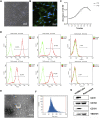CD73-Positive Small Extracellular Vesicles Derived From Umbilical Cord Mesenchymal Stem Cells Promote the Proliferation and Migration of Pediatric Urethral Smooth Muscle Cells Through Adenosine Pathway
- PMID: 35573239
- PMCID: PMC9091373
- DOI: 10.3389/fbioe.2022.895998
CD73-Positive Small Extracellular Vesicles Derived From Umbilical Cord Mesenchymal Stem Cells Promote the Proliferation and Migration of Pediatric Urethral Smooth Muscle Cells Through Adenosine Pathway
Abstract
Smooth muscle cells (SMCs) are the main functional component of urethral tissue, but are difficult to proliferate in vitro. Mesenchymal stem cells (MSCs) and mesenchymal stem cell-derived small extracellular vesicles (MSC-sEV) have been shown to promote tissue repair by regulating the proliferation and migration of different types of cells. In this study, we investigated the effect of umbilical cord mesenchymal stem cell-derived sEV (UCMSC-sEV) on the proliferation and migration of pediatric urethral smooth muscle cells (PUSMCs) and the mechanism by which sEV regulates the function of PUSMCs. We observed that UCMSC-sEV can significantly promote the proliferation and migration of PUSMCs in vitro. UCMSC-sEV exerted proliferation and migration promotion effects by carrying the CD73 to PUSMCs and catalyzing the production of adenosine. Conversely, the effect of UCMSC-sEV on the proliferation and migration of PUSMCs were no longer observed with addition of the PSB12379 as a CD73 inhibitor. It was found that the phosphatidylinositol 3-kinase (PI3K)/protein kinase B (AKT) signaling pathway in PUSMCs was activated by adenosine or UCMSC-sEV intervention. In summary, UCMSC-sEV promoted proliferation and migration of PUSMCs in vitro by activating CD73/adenosine signaling axis and downstream PI3K/AKT pathway. Thus, we concluded that UCMSC-sEV may be suggested as a new solution strategy for the urethral tissue repair.
Keywords: CD73; hypospadias; mesenchymal stem cells; migration; proliferation; small extracellular vesicles; smooth muscle cells.
Copyright © 2022 Zhang, Li, Li, Xie, He, Ling, Li, Wu, Li and Zheng.
Conflict of interest statement
The authors declare that the research was conducted in the absence of any commercial or financial relationships that could be construed as a potential conflict of interest.
Figures




Similar articles
-
CD73-positive pediatric urethral mesenchymal stem-like cell-derived small extracellular vesicles stimulate angiogenesis.Regen Ther. 2023 Dec 14;25:77-84. doi: 10.1016/j.reth.2023.12.002. eCollection 2024 Mar. Regen Ther. 2023. PMID: 38111468 Free PMC article.
-
Melatonin treatment improves human umbilical cord mesenchymal stem cell therapy in a mouse model of type II diabetes mellitus via the PI3K/AKT signaling pathway.Stem Cell Res Ther. 2022 Apr 12;13(1):164. doi: 10.1186/s13287-022-02832-0. Stem Cell Res Ther. 2022. PMID: 35414044 Free PMC article.
-
Empagliflozin-Pretreated Mesenchymal Stem Cell-Derived Small Extracellular Vesicles Attenuated Heart Injury.Oxid Med Cell Longev. 2023 Feb 18;2023:7747727. doi: 10.1155/2023/7747727. eCollection 2023. Oxid Med Cell Longev. 2023. PMID: 36852325 Free PMC article.
-
Regeneration-Related Functional Cargoes in Mesenchymal Stem Cell-Derived Small Extracellular Vesicles.Stem Cells Dev. 2020 Jan 1;29(1):15-24. doi: 10.1089/scd.2019.0131. Epub 2019 Dec 9. Stem Cells Dev. 2020. PMID: 31691632 Review.
-
Mesenchymal stem cell-derived small extracellular vesicles as cell-free therapy: Perspectives in periodontal regeneration.J Periodontal Res. 2021 Jun;56(3):433-442. doi: 10.1111/jre.12866. Epub 2021 Feb 28. J Periodontal Res. 2021. PMID: 33641196 Review.
Cited by
-
Identification and analysis of MSC-Exo-derived LncRNAs related to the regulation of EMT in hypospadias.BMC Med Genomics. 2024 Apr 16;17(1):87. doi: 10.1186/s12920-024-01869-9. BMC Med Genomics. 2024. PMID: 38627703 Free PMC article.
-
The potential therapeutic role of extracellular vesicles in osteoarthritis.Front Bioeng Biotechnol. 2022 Sep 16;10:1022368. doi: 10.3389/fbioe.2022.1022368. eCollection 2022. Front Bioeng Biotechnol. 2022. PMID: 36185451 Free PMC article. Review.
-
CD73-positive pediatric urethral mesenchymal stem-like cell-derived small extracellular vesicles stimulate angiogenesis.Regen Ther. 2023 Dec 14;25:77-84. doi: 10.1016/j.reth.2023.12.002. eCollection 2024 Mar. Regen Ther. 2023. PMID: 38111468 Free PMC article.
-
In vivo SPECT imaging of Tc-99m radiolabeled exosomes from human umbilical-cord derived mesenchymal stem cells in small animals.Biomed J. 2024 Oct;47(5):100721. doi: 10.1016/j.bj.2024.100721. Epub 2024 Apr 16. Biomed J. 2024. PMID: 38636899 Free PMC article.
References
-
- Adamiak M., Bujko K., Brzezniakiewicz-Janus K., Kucia M., Ratajczak J., Ratajczak M. Z. (2019). The Inhibition of CD39 and CD73 Cell Surface Ectonucleotidases by Small Molecular Inhibitors Enhances the Mobilization of Bone Marrow Residing Stem Cells by Decreasing the Extracellular Level of Adenosine. Stem Cel Rev Rep 15 (6), 892–899. 10.1007/s12015-019-09918-y - DOI - PMC - PubMed
LinkOut - more resources
Full Text Sources
Research Materials

